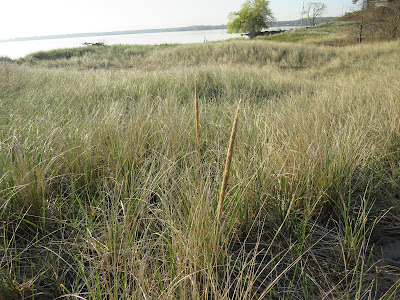The early morning wind is calm, sky is blue and the air is cold (upper 30’s) as I hike among rolling sand dunes on an isthmus separating Muskegon Lake to the east and Lake Michigan to the west (stock photo). After passing by a couple of deer, I can barely see a Wood duck drake wading in one of the marshy depressions. Continuing to explore the sandy ground, I come upon a few tiny white blossoms of Rock Cress and spikelets of Green Bulrush scattered among a sea of American Beach grass, some of which display seed heads. Nearby, another marshy depression displays a perching Green Heron. This bird forages mostly by standing still or stalking very slowly at the edge of shallow water, waiting for prey to approach. Sometimes uses "bait," dropping feather or small twig on surface of water to lure fish within striking distance. In the same area, two generations of Cattails are revealed including: young green sprouts as well as old fluffy seed heads. Approaching the western shore of Muskegon Lake, I pause to imagine a massive 200 ft sand dune that once stood here, called Pigeon Hill (stock photo). It was nesting ground for thousands of Passenger pigeons, thus earning its name. At the start of the 19th century, these pigeons were the most common bird in North America and possibly the entire world, with a population estimated at five billion. Due to rampant hunting, deforestation and disease, the bird was extinct by 1914. Walking along the beach, I notice sand ripples under the clear still lake water as well as a Ring-billed gull just offshore. Ahead, I stop to examine an old concrete block that represents a more recent part of this dune’s history. Between the 1930’s and 1960’s, Pigeon Hill was leveled as tons of sand were mined and shipped for making glass (stock photo). Down the beach, I spot a Tree Swallow perching on a white birch tree and a Spotted Sandpiper perching off-shore on a boulder. Turning around, I head back over the dunes where I observe a young Red Oak tree with its male flowers that look like drooping clusters of green peas. After watching the morning sun peak through a stand of pine trees, I notice some of the trees have apple-size growths, called Western Gall Rush. The growth is due to a fungal infection spread from pine tree to pine tree that may cause stunting and dieback of branches leading to death of the tree. Finally, I make it back to our week-end rental in time for a coffee break.
Out of the furnace you came
Earth’s depths
Molten melange
Over eons you came
Magma to mountains
Mountains to boulders
Wind and water
Weathered and worn
Rounded and rolled
Onto the dune you came
Wind-swept grains
Sand at my feet
D. DeGraaf

No comments:
Post a Comment